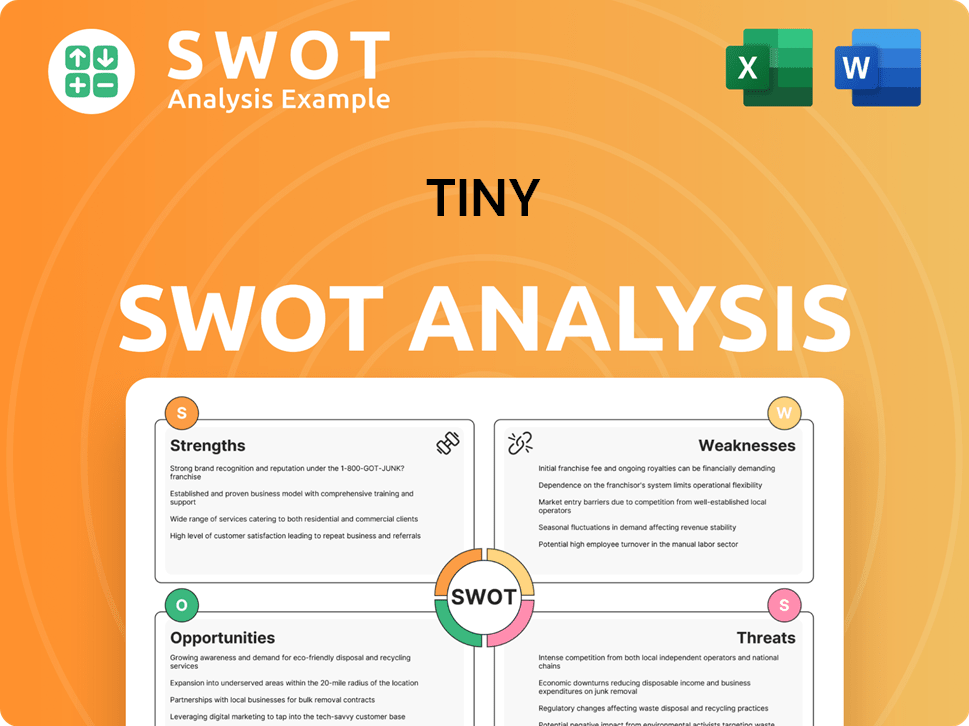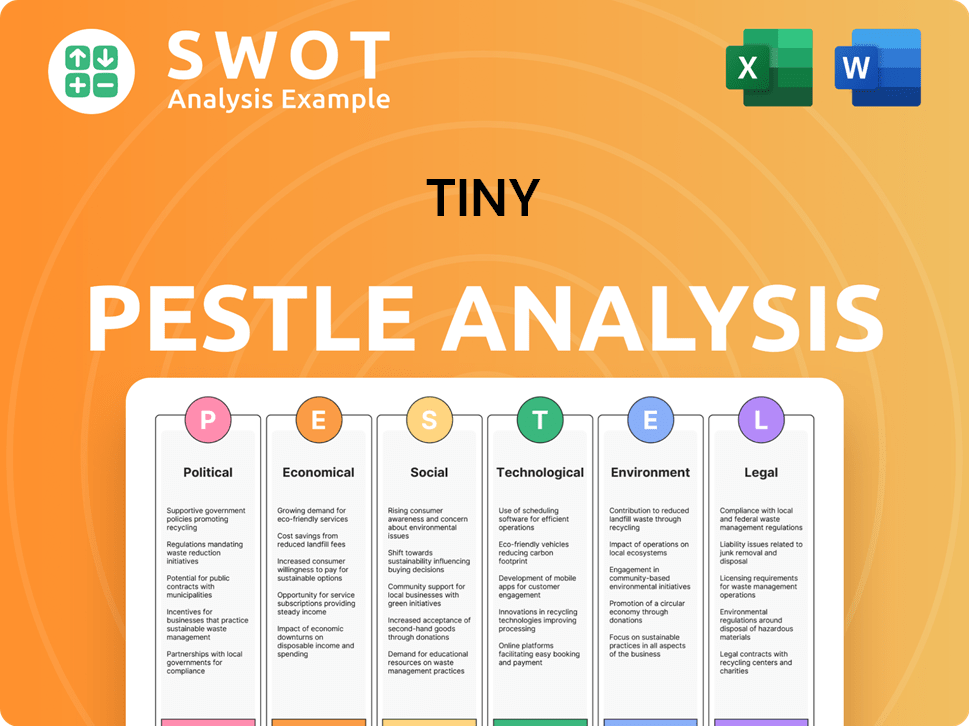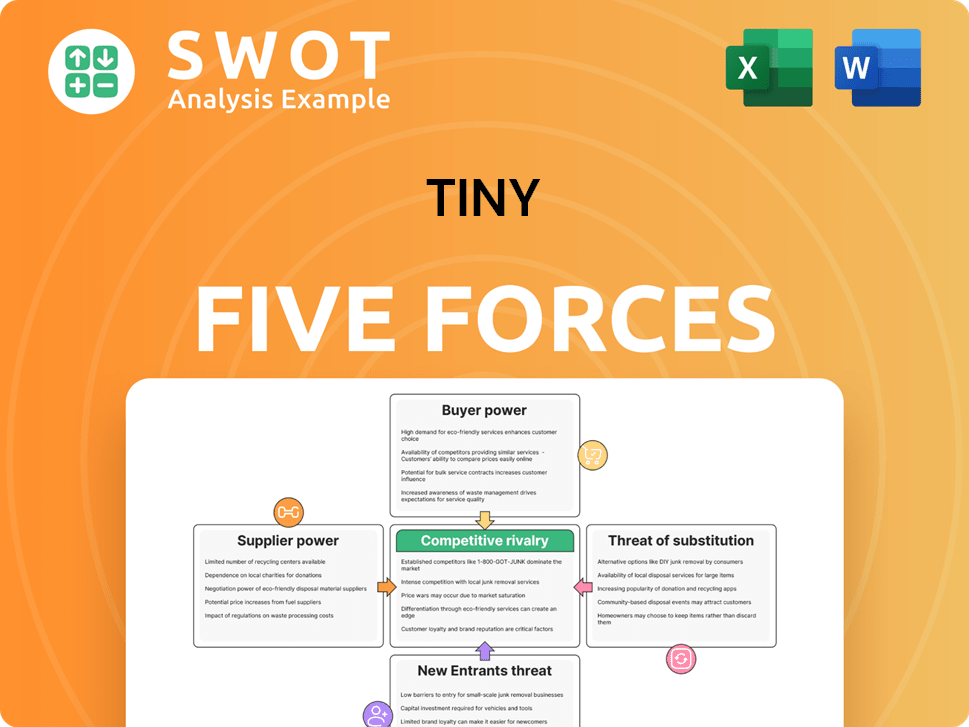Tiny Bundle
How Does Tiny Technologies Inc. Stack Up in the Digital Arena?
Tiny Technologies Inc. has carved a unique niche in the internet business landscape through its strategic acquisitions and long-term operational approach. Founded in 2007, the Canadian company focuses on acquiring and growing profitable internet businesses with strong recurring revenue streams. This approach has fueled significant growth, as demonstrated by its recent financial performance and strategic acquisitions.

Understanding the Tiny SWOT Analysis is crucial to grasping the competitive landscape. This market analysis will delve into the competitive landscape, exploring Tiny's position relative to its rivals and identifying key industry trends. We'll also examine business strategy, providing actionable insights for investors and stakeholders.
Where Does Tiny’ Stand in the Current Market?
Tiny Technologies Inc. operates as a technology holding company, distinguishing itself through a diversified portfolio spanning internet and technology-focused businesses. Its core operations are structured around three main segments: Digital Services, Software and Apps, and Creative Platform. This structure allows the company to offer comprehensive services and products, from design and marketing to software applications and digital asset marketplaces.
The value proposition of Tiny lies in its ability to provide integrated solutions across various digital domains. It supports a wide array of clients, from startups to large corporations, with services designed to enhance their online presence and operational efficiency. The company's focus on recurring revenue streams, particularly within its Software and Apps segment, highlights its commitment to long-term customer relationships and sustainable growth. To understand more about its business model, consider reading Revenue Streams & Business Model of Tiny.
In fiscal year 2024, Tiny saw a 5% increase in total revenue, reaching $194.2 million. The company's recurring revenue grew significantly by 30% from the previous year. Adjusted EBITDA for FY2024 reached $31.0 million, reflecting improved profitability.
In Q1 2025, Tiny reported total revenue of $48.1 million, a 6% increase compared to Q1 2024. Adjusted EBITDA for Q1 2025 was $9.7 million, marking a 63% increase over the same period in 2024. Recurring revenue in Q1 2025 was $9.8 million, representing 20% of total revenue.
Tiny has demonstrated a strong commitment to strengthening its balance sheet. The company repaid $24.5 million of debt in FY2024, reducing net debt to $94.1 million as of December 31, 2024. The Net Debt to Adjusted EBITDA at the end of Q1 2025 was 2.7x, indicating effective leverage management.
As of March 31, 2025, Tiny held $20.3 million in cash. The company's investment strategy primarily focuses on North America and Europe. The acquisition of Serato in May 2025 is expected to boost recurring revenue significantly, by approximately 45%, to $55 million to $57 million.
Tiny's market position is strengthened by its diversified business model and strategic acquisitions. The company competes in dynamic markets, including digital services, software, and creative platforms. Understanding the competitive landscape is crucial for Tiny company to maintain its growth trajectory.
- The market analysis reveals that Tiny's ability to integrate various services and products provides a competitive advantage.
- The company faces startup challenges common in the tech industry, such as rapid technological changes and intense competition.
- Tiny's recent acquisitions, like MediaNet Solutions and Serato, are key to its business strategy for expansion and market consolidation.
- The focus on recurring revenue and financial stability positions Tiny well for sustainable growth, despite the industry trends.
Tiny SWOT Analysis
- Complete SWOT Breakdown
- Fully Customizable
- Editable in Excel & Word
- Professional Formatting
- Investor-Ready Format

Who Are the Main Competitors Challenging Tiny?
The competitive landscape for a holding company like Tiny Technologies Inc. is multifaceted, encompassing both direct and indirect competitors across its diverse portfolio of internet businesses. A thorough market analysis reveals that Tiny faces competition from investment firms and technology conglomerates, as well as rivals within its specific operational segments, such as software and apps.
Understanding the competitive landscape is crucial for Tiny company to formulate effective business strategy. The dynamics are influenced by factors like pricing pressures and rapid innovation. Tiny's decentralized management approach requires each portfolio company to maintain its competitive edge.
Tiny's acquisition strategy, as highlighted by the Serato acquisition in May 2025, shows its proactive approach to expanding its competitive footprint. This strategy, including acquisitions like Repeat Inc., MediaNet Solutions Inc., and Wholesale Pet in 2024, underscores the importance of adapting to industry trends and addressing startup challenges.
Tiny competes with other investment firms and diversified technology conglomerates.
Key competitors include Inovia, OMERS, and ArcTern Ventures.
In the software and apps domain, competitors vary based on the specific product.
For rich text editing solutions like TinyMCE, competitors include Quill and CKSource.
Tiny actively acquires companies to expand its market presence.
The acquisition of Serato in May 2025, following a blocked merger with AlphaTheta, is a prime example.
The market is influenced by pricing pressures, innovation, and brand loyalty.
Mergers and alliances among competitors can significantly alter market dynamics.
Tiny's decentralized approach requires portfolio companies to compete individually.
Each entity must maintain its competitive edge within its specific market.
Tiny has completed 10 acquisitions.
The average acquisition amount is $29.8 million.
To gain a deeper understanding of how Tiny approaches its marketing strategy in this competitive environment, see the article Marketing Strategy of Tiny. This provides insights into how Tiny differentiates itself and builds a competitive advantage. The competitive analysis for small businesses like Tiny must consider these factors to stay ahead. Understanding Tiny company market share and how to analyze the competitive landscape of a startup is essential. Identifying key competitors of a small business and conducting a Tiny company SWOT analysis will help in building competitive advantages of a tiny company. Also, understanding the market for a new business and conducting thorough market research for a tiny company is crucial. Analyzing the competitive environment for a startup requires constant Tiny company competitive intelligence. Finally, it is important to know how to differentiate a tiny company from competitors and building a competitive strategy for a small business, as well as following best practices for competitive analysis and developing Tiny company growth strategies.
Tiny faces competition from various sources, requiring a multi-faceted approach to maintain its market position.
- The holding company competes with other investment firms.
- Its portfolio companies face competition in their respective markets.
- An active acquisition strategy is used to expand its competitive footprint.
- Market dynamics are influenced by pricing, innovation, and brand loyalty.
Tiny PESTLE Analysis
- Covers All 6 PESTLE Categories
- No Research Needed – Save Hours of Work
- Built by Experts, Trusted by Consultants
- Instant Download, Ready to Use
- 100% Editable, Fully Customizable

What Gives Tiny a Competitive Edge Over Its Rivals?
Understanding the competitive landscape of a tiny company like Tiny Technologies Inc. involves analyzing its unique advantages and strategic positioning within the market. Tiny's business strategy focuses on acquiring and operating established internet businesses, a model that shapes its competitive edge. This approach allows Tiny to build a diversified portfolio, leveraging each company's strengths while maintaining a cohesive overall strategy.
The company's ability to identify and integrate acquisitions effectively is a key factor in its growth. This includes not only finding suitable businesses but also improving their operational efficiency and profitability. This is further supported by a decentralized management structure that fosters agility and innovation within its portfolio companies. For a more detailed look at the company's origins and evolution, consider reading Brief History of Tiny.
By focusing on businesses with strong fundamentals and a founder-friendly approach, Tiny aims to create long-term value. The company's commitment to innovation, as seen in the continuous development of products like TinyMCE, further strengthens its market position and ability to adapt to industry trends.
Tiny's acquisition strategy appeals to founders seeking long-term stewardship. This approach helps secure businesses with unique competitive advantages. The focus is on companies with recurring revenue and strong free cash flow.
The decentralized structure fosters agility and faster decision-making. Portfolio companies operate largely independently, allowing them to adapt quickly. This promotes stronger ownership and accountability among employees.
Tiny identifies and transforms mismanaged businesses into profitable ventures. The company improves cost management and integrates acquisitions strategically. Q1 2025 results showed a 63% increase in Adjusted EBITDA over Q1 2024.
Tiny continually enhances its products, such as TinyMCE. The TinyMCE 7.0 release in March 2024 included new features. Ongoing integration of AI-assisted writing enhancements showcases a focus on technological advancement.
Tiny's competitive advantages stem from its unique business model and strategic focus. The company's ability to acquire and improve established businesses is a key differentiator. Its decentralized structure and focus on innovation further enhance its market position.
- Founder-friendly acquisition approach.
- Decentralized management structure.
- Focus on operational efficiency and cost management.
- Continuous product innovation and technological advancements.
Tiny Business Model Canvas
- Complete 9-Block Business Model Canvas
- Effortlessly Communicate Your Business Strategy
- Investor-Ready BMC Format
- 100% Editable and Customizable
- Clear and Structured Layout

What Industry Trends Are Reshaping Tiny’s Competitive Landscape?
The competitive landscape for Tiny Technologies Inc. is shaped by several industry trends, presenting both challenges and opportunities. The company's focus on digital transformation, personalized solutions, and AI-driven software positions it in growing markets. However, the fast pace of technological advancements and macroeconomic pressures introduce significant risks.
Tiny faces challenges related to continuous innovation, integration of acquisitions, and cybersecurity threats. Despite these, the company has opportunities to capitalize on emerging markets through strategic acquisitions and operational synergies. This approach, combined with a focus on financial resilience, allows Tiny to navigate the competitive environment effectively.
Digital transformation drives demand for software and e-commerce solutions. Personalization trends in living solutions and smart homes are also important. AI-assisted writing enhancements, like those in TinyMCE, are increasingly critical for productivity.
Rapid technological advancements require continuous innovation. Softness in the e-commerce market could impact future growth. Integration risks from acquisitions pose a challenge. Macroeconomic pressures and cybersecurity threats are also key concerns.
Strategic acquisitions allow Tiny to enter emerging markets. The acquisition of Serato is expected to increase recurring revenue. Focus on recurring revenue streams and free cash flow provides a resilient foundation. Operational integration and synergy within the portfolio offer further value.
Tiny is focused on strategic acquisitions and debt reduction. The company aims to reduce its net debt to Adjusted EBITDA ratio to 2.5x or less. This strategy, combined with evaluating additional acquisitions, supports sustained growth and resilience in a dynamic market.
The acquisition of Serato is projected to significantly boost both revenue and recurring revenue, demonstrating the impact of strategic acquisitions. Reducing the net debt to Adjusted EBITDA ratio is a key financial goal, showcasing a commitment to financial stability and resilience. Further acquisitions are planned to continue growth.
- Serato acquisition is expected to increase recurring revenue by approximately 45% and total revenue by over 20% in Q2 2025.
- Focus on businesses with recurring revenue models provides stability.
- Active exploration of operational integration and synergy within the portfolio, particularly in e-commerce.
- Ongoing development of AI-powered tools and expanded customization options within software offerings like TinyMCE.
Tiny Porter's Five Forces Analysis
- Covers All 5 Competitive Forces in Detail
- Structured for Consultants, Students, and Founders
- 100% Editable in Microsoft Word & Excel
- Instant Digital Download – Use Immediately
- Compatible with Mac & PC – Fully Unlocked

Related Blogs
- What are Mission Vision & Core Values of Tiny Company?
- What is Growth Strategy and Future Prospects of Tiny Company?
- How Does Tiny Company Work?
- What is Sales and Marketing Strategy of Tiny Company?
- What is Brief History of Tiny Company?
- Who Owns Tiny Company?
- What is Customer Demographics and Target Market of Tiny Company?
Disclaimer
All information, articles, and product details provided on this website are for general informational and educational purposes only. We do not claim any ownership over, nor do we intend to infringe upon, any trademarks, copyrights, logos, brand names, or other intellectual property mentioned or depicted on this site. Such intellectual property remains the property of its respective owners, and any references here are made solely for identification or informational purposes, without implying any affiliation, endorsement, or partnership.
We make no representations or warranties, express or implied, regarding the accuracy, completeness, or suitability of any content or products presented. Nothing on this website should be construed as legal, tax, investment, financial, medical, or other professional advice. In addition, no part of this site—including articles or product references—constitutes a solicitation, recommendation, endorsement, advertisement, or offer to buy or sell any securities, franchises, or other financial instruments, particularly in jurisdictions where such activity would be unlawful.
All content is of a general nature and may not address the specific circumstances of any individual or entity. It is not a substitute for professional advice or services. Any actions you take based on the information provided here are strictly at your own risk. You accept full responsibility for any decisions or outcomes arising from your use of this website and agree to release us from any liability in connection with your use of, or reliance upon, the content or products found herein.